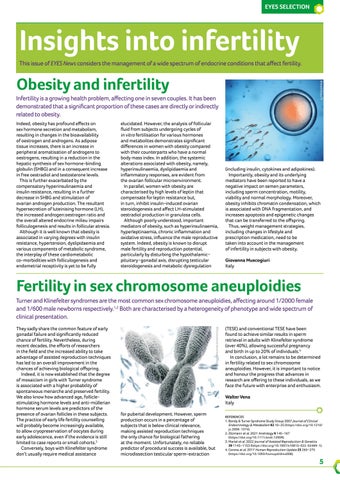EYES SELECTION
Insights into infertility
This issue of EYES News considers the management of a wide spectrum of endocrine conditions that affect fertility. ©iStock/koya79
Obesity and infertility
Infertility is a growing health problem, affecting one in seven couples. It has been demonstrated that a significant proportion of these cases are directly or indirectly related to obesity. Indeed, obesity has profound effects on sex hormone secretion and metabolism, resulting in changes in the bioavailability of oestrogen and androgens. As adipose tissue increases, there is an increase in peripheral aromatisation of androgens to oestrogens, resulting in a reduction in the hepatic synthesis of sex hormone-binding globulin (SHBG) and in a consequent increase in free oestradiol and testosterone levels. This is further exacerbated by the compensatory hyperinsulinaemia and insulin resistance, resulting in a further decrease in SHBG and stimulation of ovarian androgen production. The resultant hypersecretion of luteinising hormone (LH), the increased androgen:oestrogen ratio and the overall altered endocrine milieu impairs folliculogenesis and results in follicular atresia. Although it is well known that obesity is associated in varying degrees with insulin resistance, hypertension, dyslipidaemia and various components of metabolic syndrome, the interplay of these cardiometabolic co-morbidities with folliculogenesis and endometrial receptivity is yet to be fully
elucidated. However, the analysis of follicular fluid from subjects undergoing cycles of in vitro fertilisation for various hormones and metabolites demonstrates significant differences in women with obesity compared with their counterparts who have a normal body mass index. In addition, the systemic alterations associated with obesity, namely, hyperinsulinaemia, dyslipidaemia and inflammatory responses, are evident from the ovarian follicular microenvironment. In parallel, women with obesity are characterised by high levels of leptin that compensate for leptin resistance but, in turn, inhibit insulin-induced ovarian steroidogenesis and affect LH-stimulated oestradiol production in granulosa cells. Although poorly understood, important mediators of obesity, such as hyperinsulinaemia, hyperleptinaemia, chronic inflammation and oxidative stress, influence the male reproductive system. Indeed, obesity is known to disrupt male fertility and reproduction potential, particularly by disturbing the hypothalamic− pituitary−gonadal axis, disrupting testicular steroidogenesis and metabolic dysregulation
(including insulin, cytokines and adipokines). Importantly, obesity and its underlying mediators have been reported to have a negative impact on semen parameters, including sperm concentration, motility, viability and normal morphology. Moreover, obesity inhibits chromatin condensation, which is associated with DNA fragmentation, and increases apoptosis and epigenetic changes that can be transferred to the offspring. Thus, weight management strategies, including changes in lifestyle and prescription medication, need to be taken into account in the management of infertility in subjects with obesity. Giovanna Muscogiuri Italy
Fertility in sex chromosome aneuploidies Turner and Klinefelter syndromes are the most common sex chromosome aneuploidies, affecting around 1/2000 female and 1/600 male newborns respectively.1,2 Both are characterised by a heterogeneity of phenotype and wide spectrum of clinical presentation. ©Shutterstock/Iaremenko Sergii
They sadly share the common feature of early gonadal failure and significantly reduced chance of fertility. Nevertheless, during recent decades, the efforts of researchers in the field and the increased ability to take advantage of assisted reproduction techniques has led to an overall improvement in the chances of achieving biological offspring. Indeed, it is now established that the degree of mosaicism in girls with Turner syndrome is associated with a higher probability of spontaneous menarche and preserved fertility. We also know how advanced age, folliclestimulating hormone levels and anti-müllerian hormone serum levels are predictors of the presence of ovarian follicles in these subjects. The practice of early life fertility counselling will probably become increasingly available, to allow cryopreservation of oocytes during early adolescence, even if the evidence is still limited to case reports or small cohorts.3 Conversely, boys with Klinefelter syndrome don’t usually require medical assistance
(TESE) and conventional TESE have been found to achieve similar results in sperm retrieval in adults with Klinefelter syndrome (over 40%), allowing successful pregnancy and birth in up to 20% of individuals.4 In conclusion, a lot remains to be determined in fertility related to sex chromosome aneuploidies. However, it is important to notice and honour the progress that advances in research are offering to these individuals, as we face the future with enterprise and enthusiasm. Walter Vena Italy
for pubertal development. However, sperm production occurs in a percentage of subjects that is below clinical relevance, making assisted reproduction techniques the only chance for biological fathering at the moment. Unfortunately, no reliable predictor of procedural success is available, but microdissection testicular sperm-extraction
REFERENCES 1. Bondy & Turner Syndrome Study Group 2007 Journal of Clinical Endocrinology & Metabolism 92 10−25 (https://doi.org/10.1210/ jc.2006-1374). 2. Zitzmann et al. 2021 Andrology 9 145−167 (https://doi.org/10.1111/andr.12909). 3. Martel et al. 2022 Journal of Assisted Reproduction & Genetics 39 1143−1153 (https://doi.org/10.1007/s10815-022-02469-1). 4. Corona et al. 2017 Human Reproduction Update 23 265−275 (https://doi.org/10.1093/humupd/dmx008).
5






